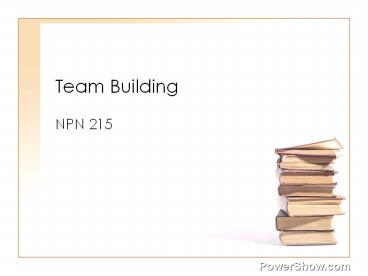Team Building - PowerPoint PPT Presentation
Title:
Team Building
Description:
Team Building. NPN 215. Composition of the Health Care Team. Physicians. Paramedics/EMT's ... Team Building. Members of the team may be from all different directions ... – PowerPoint PPT presentation
Number of Views:3499
Avg rating:3.0/5.0
Title: Team Building
1
Team Building
- NPN 215
2
Composition of the Health Care Team
- Physicians
- Paramedics/EMTs
- RN/LPN/NA/Unit clerk
- X-ray/Lab
- Respiratory/PT/OT/Speech
- Surgical Techs
- Transporters/Medical records
- Pharmacist
- Minister/Social worker
- Dietitian/Housekeeper
- Outpatient
3
Nursing Role in the Team
- Nursing Staff
- Unit managers
- RNs (3 million in US)
- AND, Diploma, BSN, MSN, Advanced Practice RN, DR.
- LPNs (700,000)
- Student nurses
- NAs
- Unit secretary
4
5 Nursing Roles
- Professional
- Provider of care
- Manager of care
- Teacher
- Researcher
5
What is a Team
- People who come together to fulfill a specific
purpose - Teams may be ongoing or formed for a specific
purpose - They are a small number of people with
complementary skills who are committed to a
common purpose and hold themselves responsible - Teams are both more or less efficient than
individuals
6
Team Building
- Members of the team may be from all different
directions - Teams are not perfect when first put together
- Michael Jordan and Arnold Palmer on a soccer team
- Teams must be put together carefully and caringly
7
Characteristics of a Team
- Must have a clear goal
- Must have a result driven structure
- Must have competent members
- Must have unified commitment
- Must be a collaborative climate
- Must have a standard of excellence
- Must have external support and recognition
- Must have a leader with standards of excellence
8
Team Work
- The health care environment does not allow us to
work independently - Patients have multiple and complex needs
- Teamwork is essential to quality, timely and cost
efficient care
9
Time Management
- Defined as a set of related common-sense skills
that helps you use your time in the most
effective and productive way possible - Or it allows us to achieve more with the
available time we have
10
Time Management
- Requires a shift from being busy to getting
things done - Pareto principle 80 of unfocused effort
results in 20 of the results or 20 of focused
efforts results in 80 of the outcomes
11
Use of Time
- 25 of the nurses time is spent charting and
reporting - 30-35 is spent on direct patient care
- The rest is spent on admission and discharge,
professional communication, personal time, and
providing care that could be provided by
unlicensed personnel, such as transportation and
housekeeping.
12
How to Use Time Effectively
- Know the big picture
- Priority setting is the most critical skill
- Constant assessment and re-prioritization of
patient needs occurs - Must decide what needs immediate attention and
what can wait, based on the patients condition
and responses to care
13
Priority Traps
- Do whatever hits first trap
- Taking the path of least resistance trap
- Responding to the squeaky wheel trap
- Completing tasks by default
- Relying on misguided inspiration
14
Setting Priorities
- Use Maslows Hierarchy of Needs
- Not every patient can be first (ER sees critical
urgent can wait to be seen) - Always protect patients and maintain safety of
patient and staff first
15
Priorities
- ABCs and equipment used to support these
systems - Vitals, LOC, pain, IV access, cardiac rhythm, O2,
suction, UOP, etc. - Urgent patients
- Safety and security
- Non- urgent patients
- Love and belonging, self-esteem, self
actualization
16
First Look Approach
- Overall
- Airway sounds
- Nasal flaring
- Eye contact
- Speech
- Interactions
- Posture
- Pain
- LOC
17
First Look Approach
- Circulation
- Color
- Flushed
- Cyanotic
- Presence of IV or oxygen
- Drainage
- Urine
- Blood
- Gastric
- Stool
- sputum
- Breathing
- Rate, symmetry, depth
- Positioning
- retractions
18
Patient Care Rounds
- May be done after information is given to you in
shift report - Perform rapid assessments
- May need to reorganize the plan for the shift
based on patient needs - Physician orders may change prn































